BUS501 Business Statistics Report: Retail Surge Profit and Attitudes
VerifiedAdded on 2023/06/04
|26
|4312
|494
Report
AI Summary
This report analyzes the business operations of an online retail company, Retail Surge, focusing on product profitability, cost of goods sold (COGS), and customer attitudes. The analysis employs ANOVA to determine significant differences in average profit and COGS across various product categories, revealing that customized items generate the highest profit but also incur the highest costs. A t-test indicates no significant difference in purchases made via PayPal versus credit card. Chi-Square tests reveal significant associations between user groups and customer attitudes, as well as gender and several customer attitudes, except for the likelihood of recommending the company. Based on these findings, the report recommends that the company focus on strategies to reduce COGS and tailor marketing efforts to address varying customer attitudes among different user groups. Desklib provides access to similar reports and solved assignments for students.
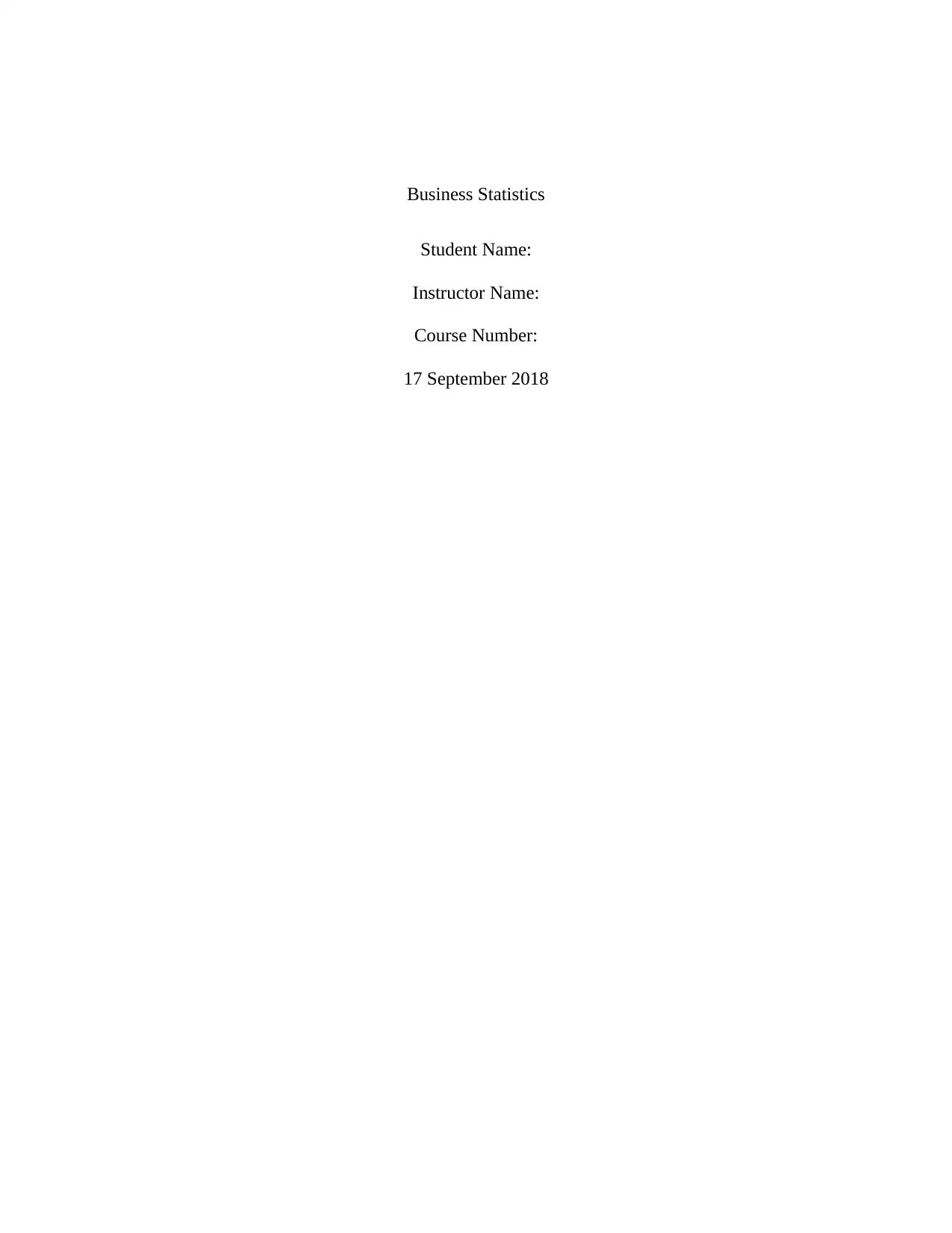
Business Statistics
Student Name:
Instructor Name:
Course Number:
17 September 2018
Student Name:
Instructor Name:
Course Number:
17 September 2018
Paraphrase This Document
Need a fresh take? Get an instant paraphrase of this document with our AI Paraphraser

Table of Contents
List of tables....................................................................................................................................2
Introduction......................................................................................................................................3
Problem definition and business intelligence required....................................................................3
Results of the selected analytics methods and technical analysis....................................................4
Which product categories are making the most profit?...............................................................4
Which product category costs the most (COGS)?.......................................................................6
Is there a difference in payments methods?.................................................................................7
Are there any differences in the user groups on all of the customer attitudes?...........................8
Are there any differences in gender on all of the customer attitudes?.........................................9
Discussion of the results and recommendations............................................................................10
Recommendations..........................................................................................................................10
References......................................................................................................................................11
Appendix........................................................................................................................................12
List of tables....................................................................................................................................2
Introduction......................................................................................................................................3
Problem definition and business intelligence required....................................................................3
Results of the selected analytics methods and technical analysis....................................................4
Which product categories are making the most profit?...............................................................4
Which product category costs the most (COGS)?.......................................................................6
Is there a difference in payments methods?.................................................................................7
Are there any differences in the user groups on all of the customer attitudes?...........................8
Are there any differences in gender on all of the customer attitudes?.........................................9
Discussion of the results and recommendations............................................................................10
Recommendations..........................................................................................................................10
References......................................................................................................................................11
Appendix........................................................................................................................................12
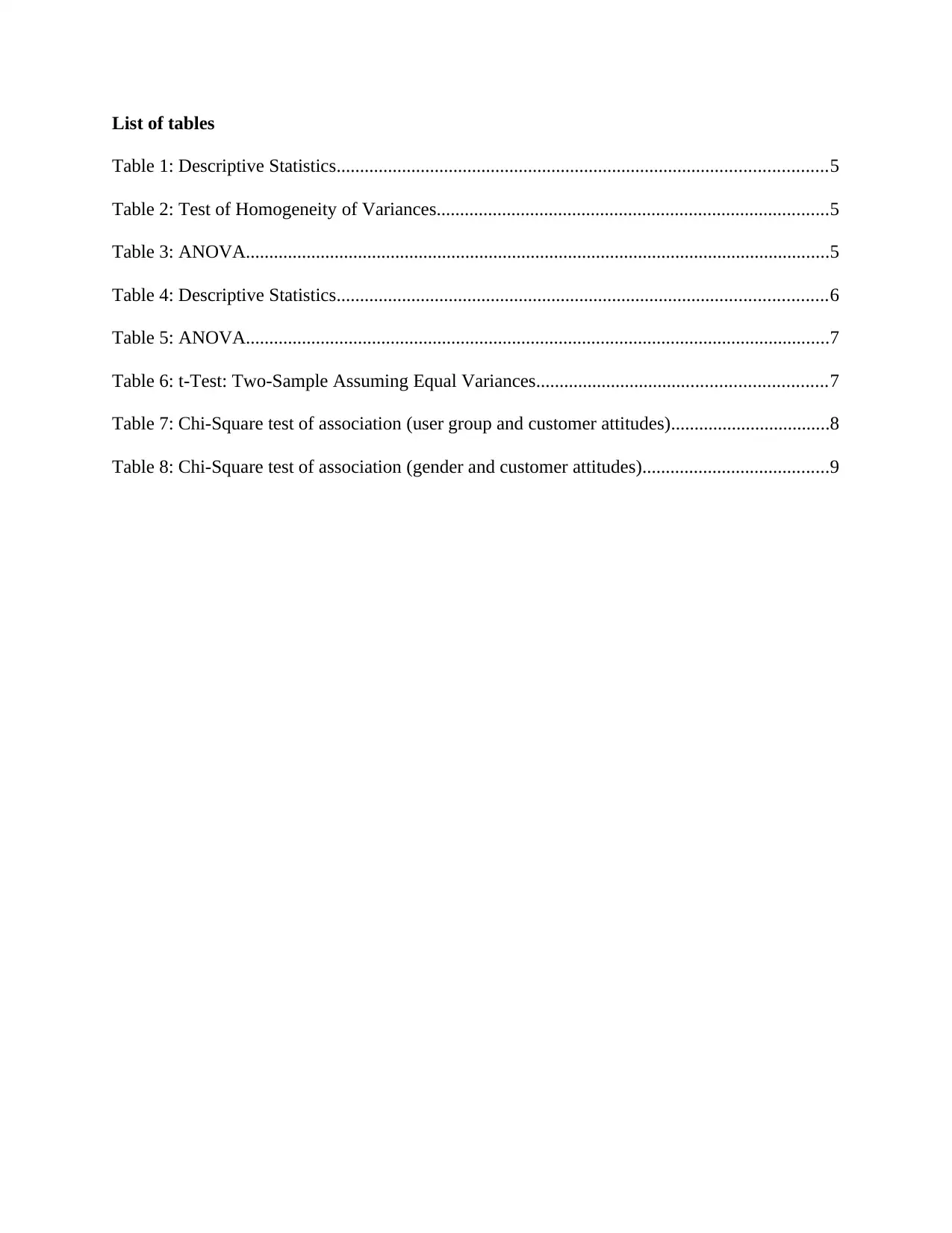
List of tables
Table 1: Descriptive Statistics.........................................................................................................5
Table 2: Test of Homogeneity of Variances....................................................................................5
Table 3: ANOVA.............................................................................................................................5
Table 4: Descriptive Statistics.........................................................................................................6
Table 5: ANOVA.............................................................................................................................7
Table 6: t-Test: Two-Sample Assuming Equal Variances..............................................................7
Table 7: Chi-Square test of association (user group and customer attitudes)..................................8
Table 8: Chi-Square test of association (gender and customer attitudes)........................................9
Table 1: Descriptive Statistics.........................................................................................................5
Table 2: Test of Homogeneity of Variances....................................................................................5
Table 3: ANOVA.............................................................................................................................5
Table 4: Descriptive Statistics.........................................................................................................6
Table 5: ANOVA.............................................................................................................................7
Table 6: t-Test: Two-Sample Assuming Equal Variances..............................................................7
Table 7: Chi-Square test of association (user group and customer attitudes)..................................8
Table 8: Chi-Square test of association (gender and customer attitudes)........................................9
⊘ This is a preview!⊘
Do you want full access?
Subscribe today to unlock all pages.

Trusted by 1+ million students worldwide
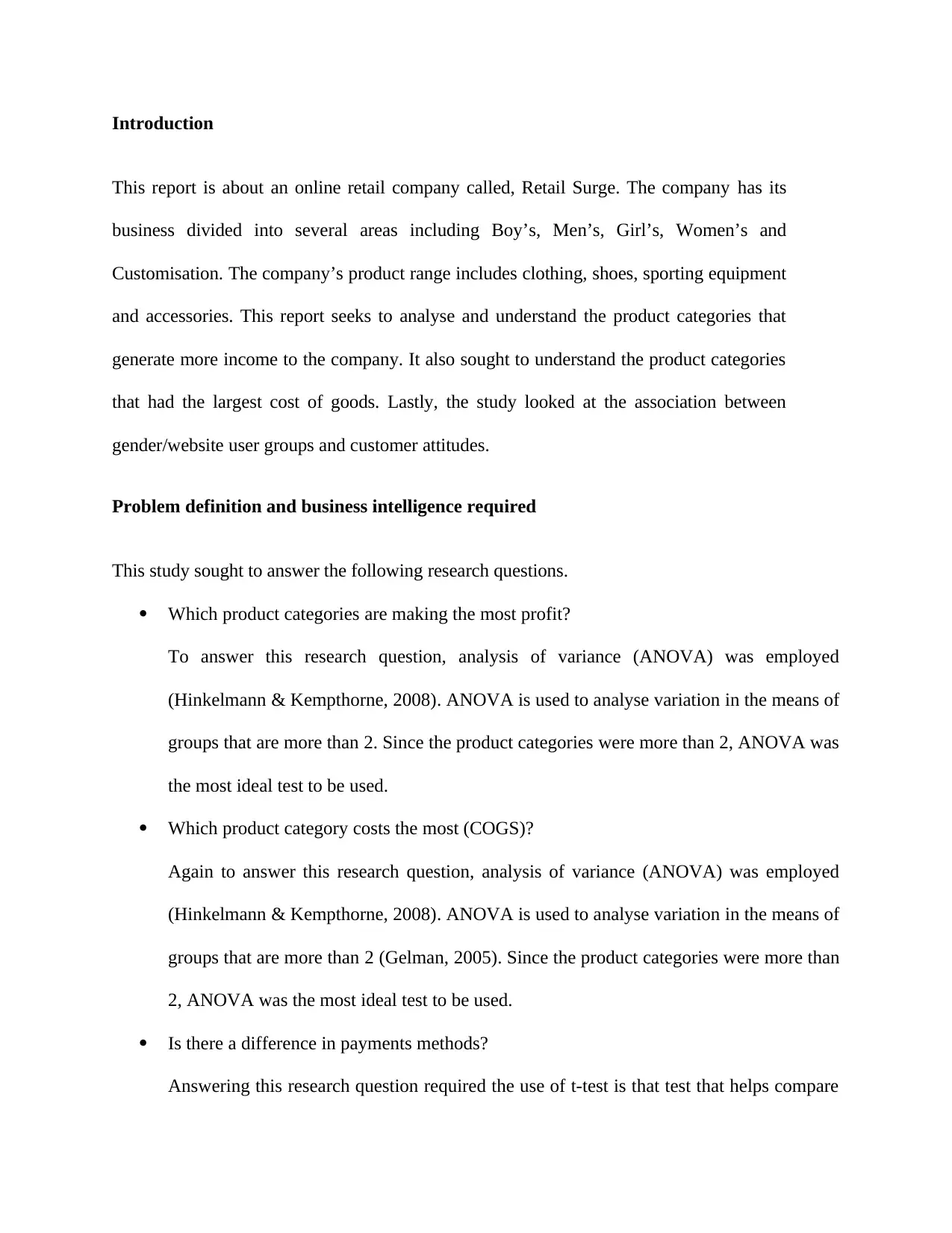
Introduction
This report is about an online retail company called, Retail Surge. The company has its
business divided into several areas including Boy’s, Men’s, Girl’s, Women’s and
Customisation. The company’s product range includes clothing, shoes, sporting equipment
and accessories. This report seeks to analyse and understand the product categories that
generate more income to the company. It also sought to understand the product categories
that had the largest cost of goods. Lastly, the study looked at the association between
gender/website user groups and customer attitudes.
Problem definition and business intelligence required
This study sought to answer the following research questions.
Which product categories are making the most profit?
To answer this research question, analysis of variance (ANOVA) was employed
(Hinkelmann & Kempthorne, 2008). ANOVA is used to analyse variation in the means of
groups that are more than 2. Since the product categories were more than 2, ANOVA was
the most ideal test to be used.
Which product category costs the most (COGS)?
Again to answer this research question, analysis of variance (ANOVA) was employed
(Hinkelmann & Kempthorne, 2008). ANOVA is used to analyse variation in the means of
groups that are more than 2 (Gelman, 2005). Since the product categories were more than
2, ANOVA was the most ideal test to be used.
Is there a difference in payments methods?
Answering this research question required the use of t-test is that test that helps compare
This report is about an online retail company called, Retail Surge. The company has its
business divided into several areas including Boy’s, Men’s, Girl’s, Women’s and
Customisation. The company’s product range includes clothing, shoes, sporting equipment
and accessories. This report seeks to analyse and understand the product categories that
generate more income to the company. It also sought to understand the product categories
that had the largest cost of goods. Lastly, the study looked at the association between
gender/website user groups and customer attitudes.
Problem definition and business intelligence required
This study sought to answer the following research questions.
Which product categories are making the most profit?
To answer this research question, analysis of variance (ANOVA) was employed
(Hinkelmann & Kempthorne, 2008). ANOVA is used to analyse variation in the means of
groups that are more than 2. Since the product categories were more than 2, ANOVA was
the most ideal test to be used.
Which product category costs the most (COGS)?
Again to answer this research question, analysis of variance (ANOVA) was employed
(Hinkelmann & Kempthorne, 2008). ANOVA is used to analyse variation in the means of
groups that are more than 2 (Gelman, 2005). Since the product categories were more than
2, ANOVA was the most ideal test to be used.
Is there a difference in payments methods?
Answering this research question required the use of t-test is that test that helps compare
Paraphrase This Document
Need a fresh take? Get an instant paraphrase of this document with our AI Paraphraser
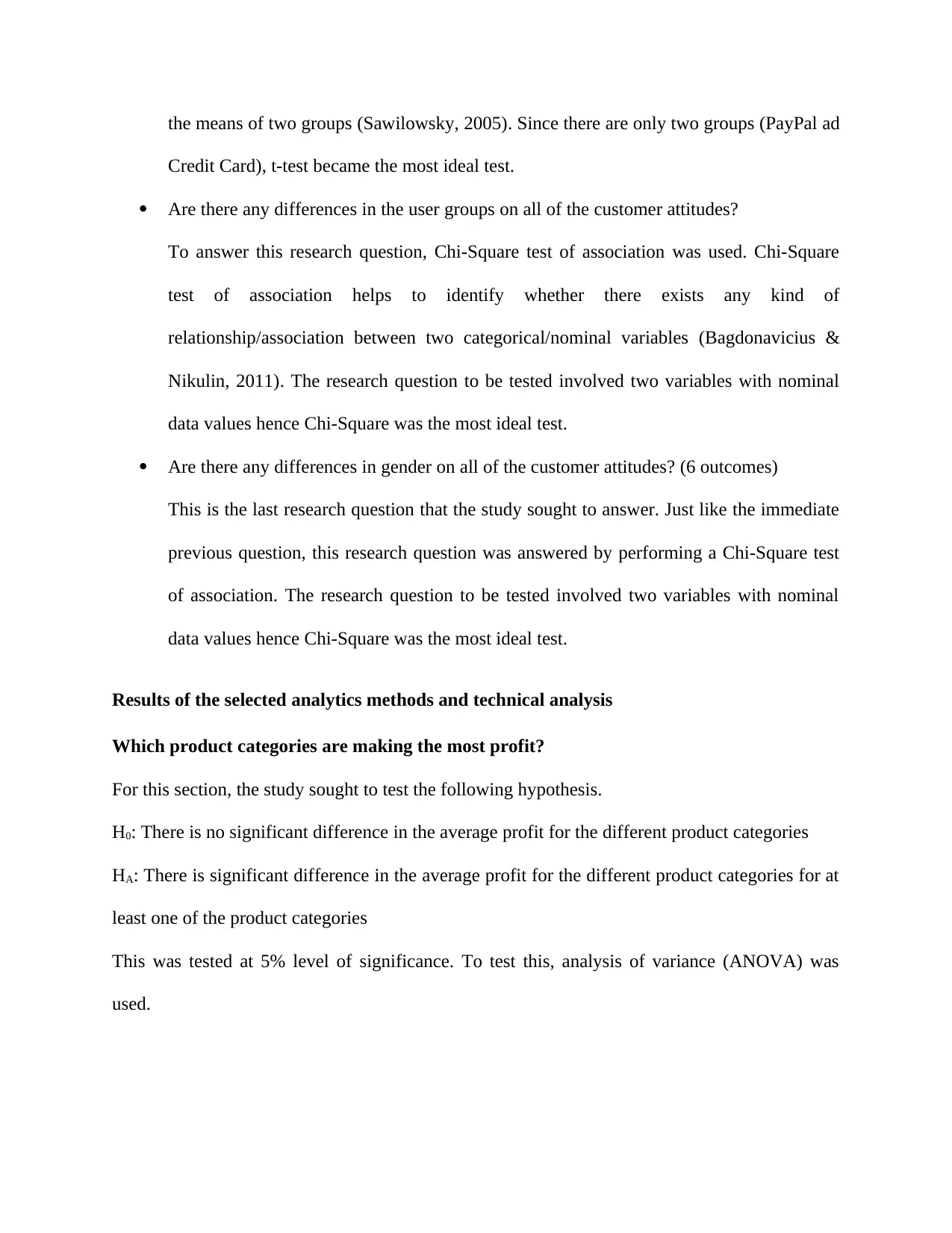
the means of two groups (Sawilowsky, 2005). Since there are only two groups (PayPal ad
Credit Card), t-test became the most ideal test.
Are there any differences in the user groups on all of the customer attitudes?
To answer this research question, Chi-Square test of association was used. Chi-Square
test of association helps to identify whether there exists any kind of
relationship/association between two categorical/nominal variables (Bagdonavicius &
Nikulin, 2011). The research question to be tested involved two variables with nominal
data values hence Chi-Square was the most ideal test.
Are there any differences in gender on all of the customer attitudes? (6 outcomes)
This is the last research question that the study sought to answer. Just like the immediate
previous question, this research question was answered by performing a Chi-Square test
of association. The research question to be tested involved two variables with nominal
data values hence Chi-Square was the most ideal test.
Results of the selected analytics methods and technical analysis
Which product categories are making the most profit?
For this section, the study sought to test the following hypothesis.
H0: There is no significant difference in the average profit for the different product categories
HA: There is significant difference in the average profit for the different product categories for at
least one of the product categories
This was tested at 5% level of significance. To test this, analysis of variance (ANOVA) was
used.
Credit Card), t-test became the most ideal test.
Are there any differences in the user groups on all of the customer attitudes?
To answer this research question, Chi-Square test of association was used. Chi-Square
test of association helps to identify whether there exists any kind of
relationship/association between two categorical/nominal variables (Bagdonavicius &
Nikulin, 2011). The research question to be tested involved two variables with nominal
data values hence Chi-Square was the most ideal test.
Are there any differences in gender on all of the customer attitudes? (6 outcomes)
This is the last research question that the study sought to answer. Just like the immediate
previous question, this research question was answered by performing a Chi-Square test
of association. The research question to be tested involved two variables with nominal
data values hence Chi-Square was the most ideal test.
Results of the selected analytics methods and technical analysis
Which product categories are making the most profit?
For this section, the study sought to test the following hypothesis.
H0: There is no significant difference in the average profit for the different product categories
HA: There is significant difference in the average profit for the different product categories for at
least one of the product categories
This was tested at 5% level of significance. To test this, analysis of variance (ANOVA) was
used.

Table 1: Descriptive Statistics
N Mean Std.
Deviatio
n
Std.
Error
95% Confidence Interval for
Mean
Lower Bound Upper Bound
Men’s shoes 91 15.8934 .40738 .04270 15.8086 15.9782
Men’s clothing 78 6.0000 .00000 .00000 6.0000 6.0000
Women’s shoes 13 6.5000 .00000 .00000 6.5000 6.5000
Women’s clothing 348 4.2000 .00000 .00000 4.2000 4.2000
Customize 27 25.0000 .00000 .00000 25.0000 25.0000
Boy’s shoes 51 3.3000 .00000 .00000 3.3000 3.3000
Girl’s shoes 2 7.0000 .00000 .00000 7.0000 7.0000
Girl’s clothing 2 4.0000 .00000 .00000 4.0000 4.0000
Total 612 7.0681 5.64691 .22826 6.6199 7.5164
From the descriptive table above, it can be seen that the product with the highest profit to be the
customized items (M = 25.00, SD = 0.00). The product with the least profit was the boy’s shoes
(M = 3.30, SD = 0.00).
Table 2: Test of Homogeneity of Variances
Profit Total
Levene Statistic df1 df2 Sig.
16.253 7 604 .000
Before running the ANOVA, we checked for the homogeneity of variances. Levene’s test of
homogeneity showed that the variances are not homogenous (not equal).
Table 3: ANOVA
Sum of Squares df Mean Square F Sig.
Between Groups 19468.353 7 2781.193 112468.919 .000
Within Groups 14.936 604 .025
Total 19483.289 611
N Mean Std.
Deviatio
n
Std.
Error
95% Confidence Interval for
Mean
Lower Bound Upper Bound
Men’s shoes 91 15.8934 .40738 .04270 15.8086 15.9782
Men’s clothing 78 6.0000 .00000 .00000 6.0000 6.0000
Women’s shoes 13 6.5000 .00000 .00000 6.5000 6.5000
Women’s clothing 348 4.2000 .00000 .00000 4.2000 4.2000
Customize 27 25.0000 .00000 .00000 25.0000 25.0000
Boy’s shoes 51 3.3000 .00000 .00000 3.3000 3.3000
Girl’s shoes 2 7.0000 .00000 .00000 7.0000 7.0000
Girl’s clothing 2 4.0000 .00000 .00000 4.0000 4.0000
Total 612 7.0681 5.64691 .22826 6.6199 7.5164
From the descriptive table above, it can be seen that the product with the highest profit to be the
customized items (M = 25.00, SD = 0.00). The product with the least profit was the boy’s shoes
(M = 3.30, SD = 0.00).
Table 2: Test of Homogeneity of Variances
Profit Total
Levene Statistic df1 df2 Sig.
16.253 7 604 .000
Before running the ANOVA, we checked for the homogeneity of variances. Levene’s test of
homogeneity showed that the variances are not homogenous (not equal).
Table 3: ANOVA
Sum of Squares df Mean Square F Sig.
Between Groups 19468.353 7 2781.193 112468.919 .000
Within Groups 14.936 604 .025
Total 19483.289 611
⊘ This is a preview!⊘
Do you want full access?
Subscribe today to unlock all pages.

Trusted by 1+ million students worldwide
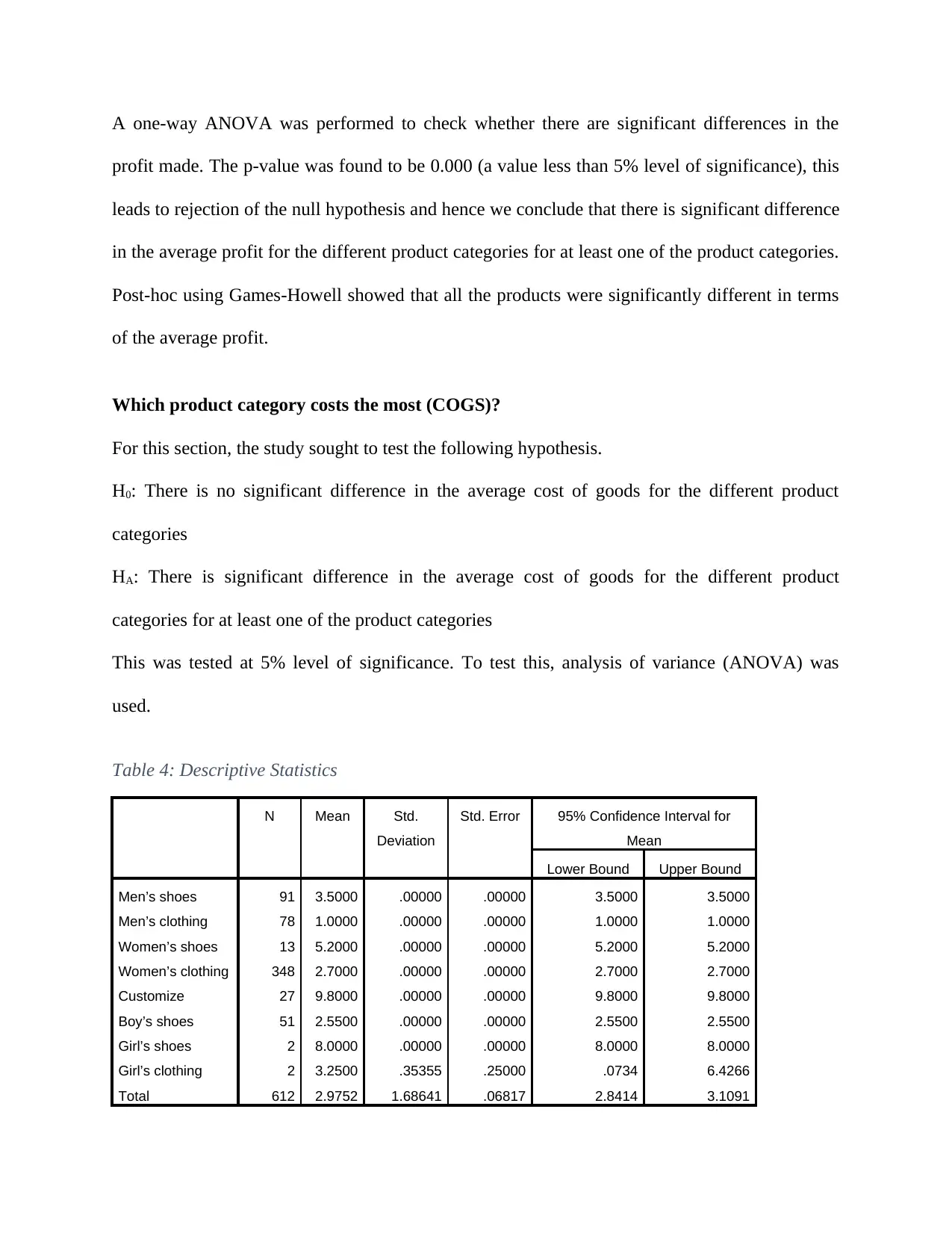
A one-way ANOVA was performed to check whether there are significant differences in the
profit made. The p-value was found to be 0.000 (a value less than 5% level of significance), this
leads to rejection of the null hypothesis and hence we conclude that there is significant difference
in the average profit for the different product categories for at least one of the product categories.
Post-hoc using Games-Howell showed that all the products were significantly different in terms
of the average profit.
Which product category costs the most (COGS)?
For this section, the study sought to test the following hypothesis.
H0: There is no significant difference in the average cost of goods for the different product
categories
HA: There is significant difference in the average cost of goods for the different product
categories for at least one of the product categories
This was tested at 5% level of significance. To test this, analysis of variance (ANOVA) was
used.
Table 4: Descriptive Statistics
N Mean Std.
Deviation
Std. Error 95% Confidence Interval for
Mean
Lower Bound Upper Bound
Men’s shoes 91 3.5000 .00000 .00000 3.5000 3.5000
Men’s clothing 78 1.0000 .00000 .00000 1.0000 1.0000
Women’s shoes 13 5.2000 .00000 .00000 5.2000 5.2000
Women’s clothing 348 2.7000 .00000 .00000 2.7000 2.7000
Customize 27 9.8000 .00000 .00000 9.8000 9.8000
Boy’s shoes 51 2.5500 .00000 .00000 2.5500 2.5500
Girl’s shoes 2 8.0000 .00000 .00000 8.0000 8.0000
Girl’s clothing 2 3.2500 .35355 .25000 .0734 6.4266
Total 612 2.9752 1.68641 .06817 2.8414 3.1091
profit made. The p-value was found to be 0.000 (a value less than 5% level of significance), this
leads to rejection of the null hypothesis and hence we conclude that there is significant difference
in the average profit for the different product categories for at least one of the product categories.
Post-hoc using Games-Howell showed that all the products were significantly different in terms
of the average profit.
Which product category costs the most (COGS)?
For this section, the study sought to test the following hypothesis.
H0: There is no significant difference in the average cost of goods for the different product
categories
HA: There is significant difference in the average cost of goods for the different product
categories for at least one of the product categories
This was tested at 5% level of significance. To test this, analysis of variance (ANOVA) was
used.
Table 4: Descriptive Statistics
N Mean Std.
Deviation
Std. Error 95% Confidence Interval for
Mean
Lower Bound Upper Bound
Men’s shoes 91 3.5000 .00000 .00000 3.5000 3.5000
Men’s clothing 78 1.0000 .00000 .00000 1.0000 1.0000
Women’s shoes 13 5.2000 .00000 .00000 5.2000 5.2000
Women’s clothing 348 2.7000 .00000 .00000 2.7000 2.7000
Customize 27 9.8000 .00000 .00000 9.8000 9.8000
Boy’s shoes 51 2.5500 .00000 .00000 2.5500 2.5500
Girl’s shoes 2 8.0000 .00000 .00000 8.0000 8.0000
Girl’s clothing 2 3.2500 .35355 .25000 .0734 6.4266
Total 612 2.9752 1.68641 .06817 2.8414 3.1091
Paraphrase This Document
Need a fresh take? Get an instant paraphrase of this document with our AI Paraphraser

From the descriptive table above, it can be seen that the product with the highest cost of goods to
be the customized items (M = 9.80.00, SD = 0.00). The product with the least average cost of
goods was the men’s clothing (M = 1.00, SD = 0.00).
Table 5: ANOVA
Cost of Goods ($)
Sum of Squares df Mean Square F Sig.
Between Groups 1737.547 7 248.221 1199404.192 .000
Within Groups .125 604 .000
Total 1737.672 611
A one-way ANOVA was performed to check whether there are significant differences in the cost
of goods (COGs). The p-value was found to be 0.000 (a value less than 5% level of significance),
this leads to rejection of the null hypothesis and hence we conclude that there is significant
difference in the average cost of goods for the different product categories for at least one of the
product categories. Post-hoc using Games-Howell showed that all the products were significantly
different in terms average cost of goods.
Is there a difference in payments methods?
Next, we sought to find out whether there is significant difference in payment methods. To test
this, the following hypothesis was tested at 5% level;
H0: There is no significant difference average total purchases paid with PayPal and Credit Card
H0: There is significant difference average total purchases paid with PayPal and Credit Card
The results are given below;
Table 6: t-Test: Two-Sample Assuming Equal Variances
PayPal Credit Card
Mean 3.42402 3.630229
Variance 13.00117 19.39701
be the customized items (M = 9.80.00, SD = 0.00). The product with the least average cost of
goods was the men’s clothing (M = 1.00, SD = 0.00).
Table 5: ANOVA
Cost of Goods ($)
Sum of Squares df Mean Square F Sig.
Between Groups 1737.547 7 248.221 1199404.192 .000
Within Groups .125 604 .000
Total 1737.672 611
A one-way ANOVA was performed to check whether there are significant differences in the cost
of goods (COGs). The p-value was found to be 0.000 (a value less than 5% level of significance),
this leads to rejection of the null hypothesis and hence we conclude that there is significant
difference in the average cost of goods for the different product categories for at least one of the
product categories. Post-hoc using Games-Howell showed that all the products were significantly
different in terms average cost of goods.
Is there a difference in payments methods?
Next, we sought to find out whether there is significant difference in payment methods. To test
this, the following hypothesis was tested at 5% level;
H0: There is no significant difference average total purchases paid with PayPal and Credit Card
H0: There is significant difference average total purchases paid with PayPal and Credit Card
The results are given below;
Table 6: t-Test: Two-Sample Assuming Equal Variances
PayPal Credit Card
Mean 3.42402 3.630229
Variance 13.00117 19.39701
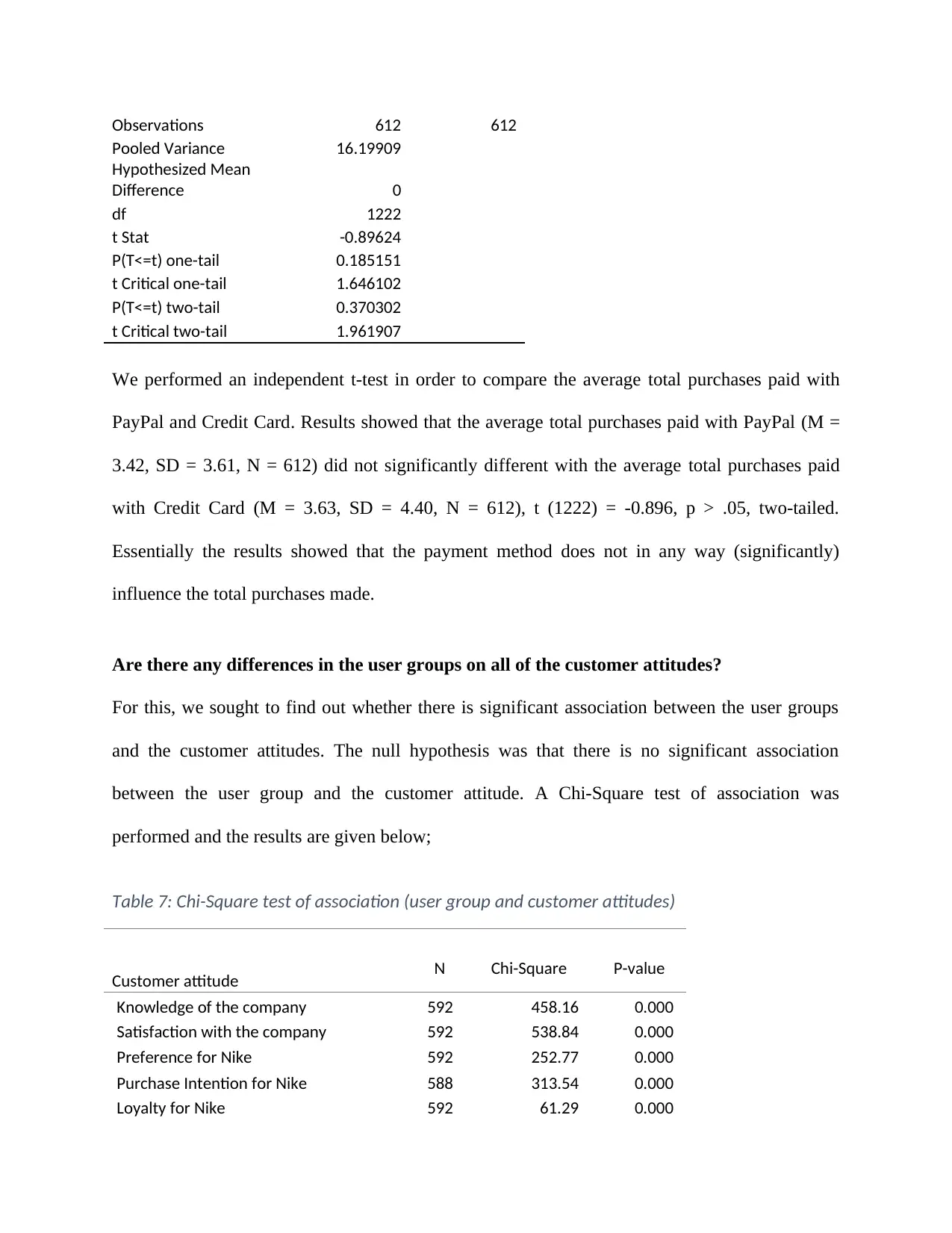
Observations 612 612
Pooled Variance 16.19909
Hypothesized Mean
Difference 0
df 1222
t Stat -0.89624
P(T<=t) one-tail 0.185151
t Critical one-tail 1.646102
P(T<=t) two-tail 0.370302
t Critical two-tail 1.961907
We performed an independent t-test in order to compare the average total purchases paid with
PayPal and Credit Card. Results showed that the average total purchases paid with PayPal (M =
3.42, SD = 3.61, N = 612) did not significantly different with the average total purchases paid
with Credit Card (M = 3.63, SD = 4.40, N = 612), t (1222) = -0.896, p > .05, two-tailed.
Essentially the results showed that the payment method does not in any way (significantly)
influence the total purchases made.
Are there any differences in the user groups on all of the customer attitudes?
For this, we sought to find out whether there is significant association between the user groups
and the customer attitudes. The null hypothesis was that there is no significant association
between the user group and the customer attitude. A Chi-Square test of association was
performed and the results are given below;
Table 7: Chi-Square test of association (user group and customer attitudes)
Customer attitude N Chi-Square P-value
Knowledge of the company 592 458.16 0.000
Satisfaction with the company 592 538.84 0.000
Preference for Nike 592 252.77 0.000
Purchase Intention for Nike 588 313.54 0.000
Loyalty for Nike 592 61.29 0.000
Pooled Variance 16.19909
Hypothesized Mean
Difference 0
df 1222
t Stat -0.89624
P(T<=t) one-tail 0.185151
t Critical one-tail 1.646102
P(T<=t) two-tail 0.370302
t Critical two-tail 1.961907
We performed an independent t-test in order to compare the average total purchases paid with
PayPal and Credit Card. Results showed that the average total purchases paid with PayPal (M =
3.42, SD = 3.61, N = 612) did not significantly different with the average total purchases paid
with Credit Card (M = 3.63, SD = 4.40, N = 612), t (1222) = -0.896, p > .05, two-tailed.
Essentially the results showed that the payment method does not in any way (significantly)
influence the total purchases made.
Are there any differences in the user groups on all of the customer attitudes?
For this, we sought to find out whether there is significant association between the user groups
and the customer attitudes. The null hypothesis was that there is no significant association
between the user group and the customer attitude. A Chi-Square test of association was
performed and the results are given below;
Table 7: Chi-Square test of association (user group and customer attitudes)
Customer attitude N Chi-Square P-value
Knowledge of the company 592 458.16 0.000
Satisfaction with the company 592 538.84 0.000
Preference for Nike 592 252.77 0.000
Purchase Intention for Nike 588 313.54 0.000
Loyalty for Nike 592 61.29 0.000
⊘ This is a preview!⊘
Do you want full access?
Subscribe today to unlock all pages.

Trusted by 1+ million students worldwide
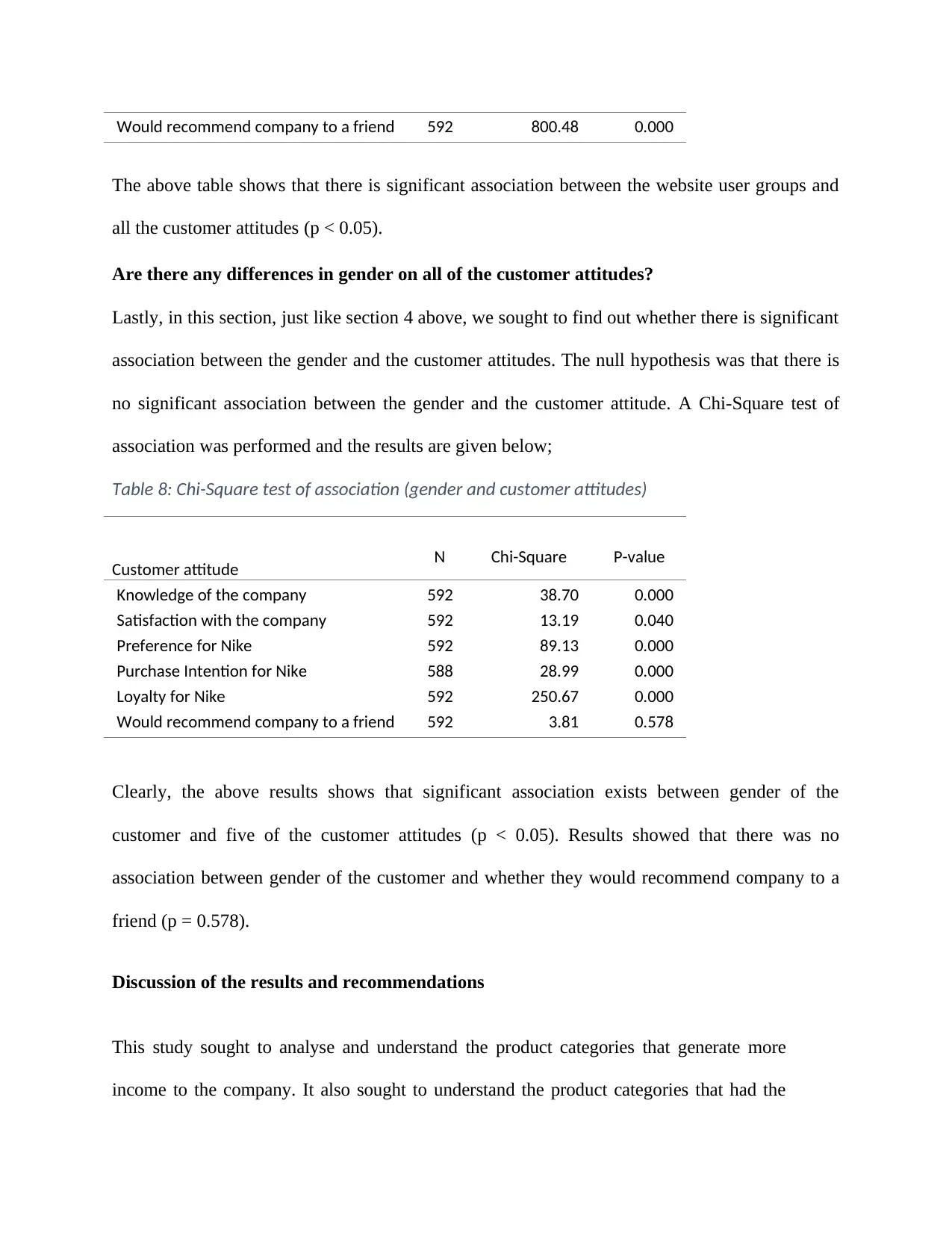
Would recommend company to a friend 592 800.48 0.000
The above table shows that there is significant association between the website user groups and
all the customer attitudes (p < 0.05).
Are there any differences in gender on all of the customer attitudes?
Lastly, in this section, just like section 4 above, we sought to find out whether there is significant
association between the gender and the customer attitudes. The null hypothesis was that there is
no significant association between the gender and the customer attitude. A Chi-Square test of
association was performed and the results are given below;
Table 8: Chi-Square test of association (gender and customer attitudes)
Customer attitude N Chi-Square P-value
Knowledge of the company 592 38.70 0.000
Satisfaction with the company 592 13.19 0.040
Preference for Nike 592 89.13 0.000
Purchase Intention for Nike 588 28.99 0.000
Loyalty for Nike 592 250.67 0.000
Would recommend company to a friend 592 3.81 0.578
Clearly, the above results shows that significant association exists between gender of the
customer and five of the customer attitudes (p < 0.05). Results showed that there was no
association between gender of the customer and whether they would recommend company to a
friend (p = 0.578).
Discussion of the results and recommendations
This study sought to analyse and understand the product categories that generate more
income to the company. It also sought to understand the product categories that had the
The above table shows that there is significant association between the website user groups and
all the customer attitudes (p < 0.05).
Are there any differences in gender on all of the customer attitudes?
Lastly, in this section, just like section 4 above, we sought to find out whether there is significant
association between the gender and the customer attitudes. The null hypothesis was that there is
no significant association between the gender and the customer attitude. A Chi-Square test of
association was performed and the results are given below;
Table 8: Chi-Square test of association (gender and customer attitudes)
Customer attitude N Chi-Square P-value
Knowledge of the company 592 38.70 0.000
Satisfaction with the company 592 13.19 0.040
Preference for Nike 592 89.13 0.000
Purchase Intention for Nike 588 28.99 0.000
Loyalty for Nike 592 250.67 0.000
Would recommend company to a friend 592 3.81 0.578
Clearly, the above results shows that significant association exists between gender of the
customer and five of the customer attitudes (p < 0.05). Results showed that there was no
association between gender of the customer and whether they would recommend company to a
friend (p = 0.578).
Discussion of the results and recommendations
This study sought to analyse and understand the product categories that generate more
income to the company. It also sought to understand the product categories that had the
Paraphrase This Document
Need a fresh take? Get an instant paraphrase of this document with our AI Paraphraser
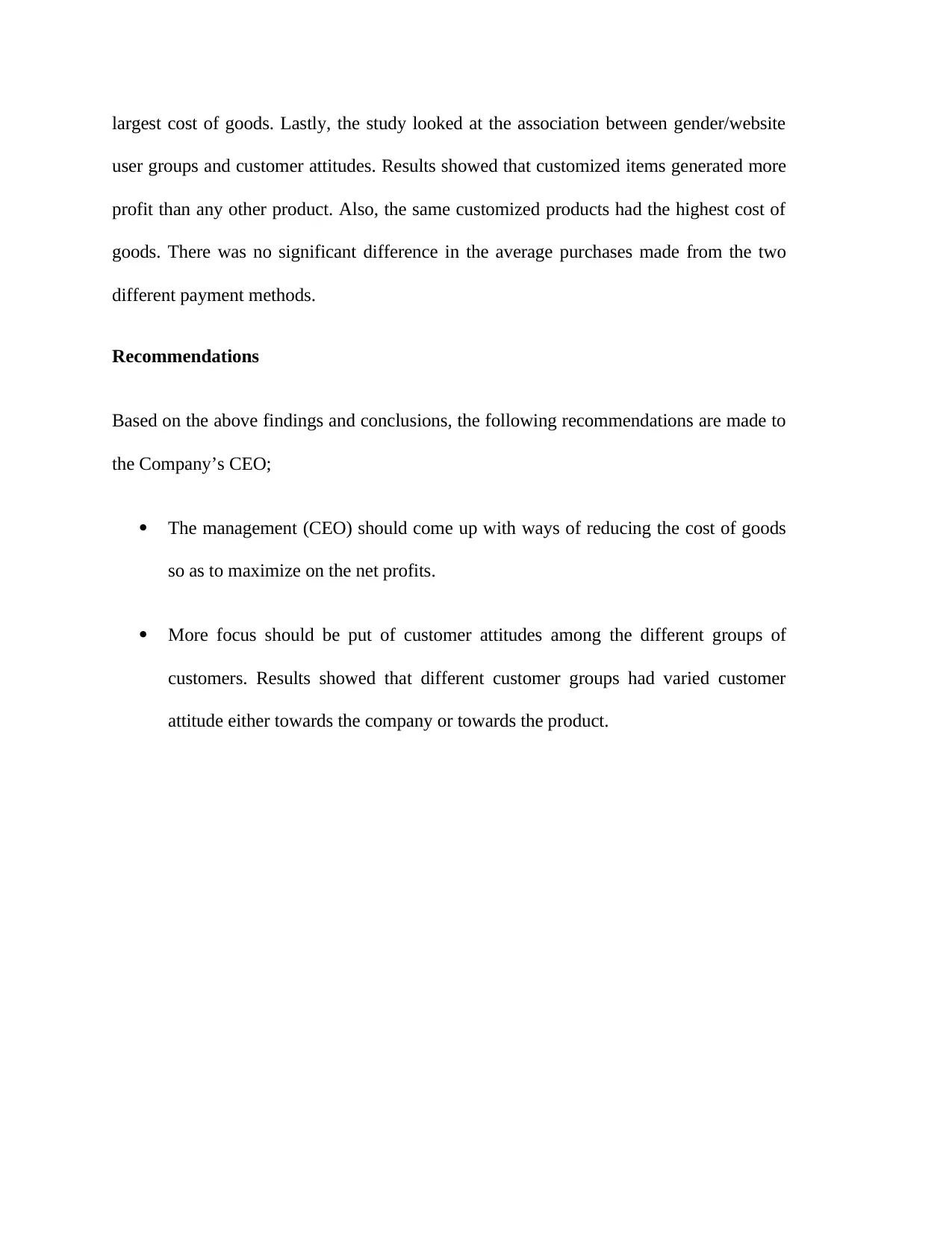
largest cost of goods. Lastly, the study looked at the association between gender/website
user groups and customer attitudes. Results showed that customized items generated more
profit than any other product. Also, the same customized products had the highest cost of
goods. There was no significant difference in the average purchases made from the two
different payment methods.
Recommendations
Based on the above findings and conclusions, the following recommendations are made to
the Company’s CEO;
The management (CEO) should come up with ways of reducing the cost of goods
so as to maximize on the net profits.
More focus should be put of customer attitudes among the different groups of
customers. Results showed that different customer groups had varied customer
attitude either towards the company or towards the product.
user groups and customer attitudes. Results showed that customized items generated more
profit than any other product. Also, the same customized products had the highest cost of
goods. There was no significant difference in the average purchases made from the two
different payment methods.
Recommendations
Based on the above findings and conclusions, the following recommendations are made to
the Company’s CEO;
The management (CEO) should come up with ways of reducing the cost of goods
so as to maximize on the net profits.
More focus should be put of customer attitudes among the different groups of
customers. Results showed that different customer groups had varied customer
attitude either towards the company or towards the product.
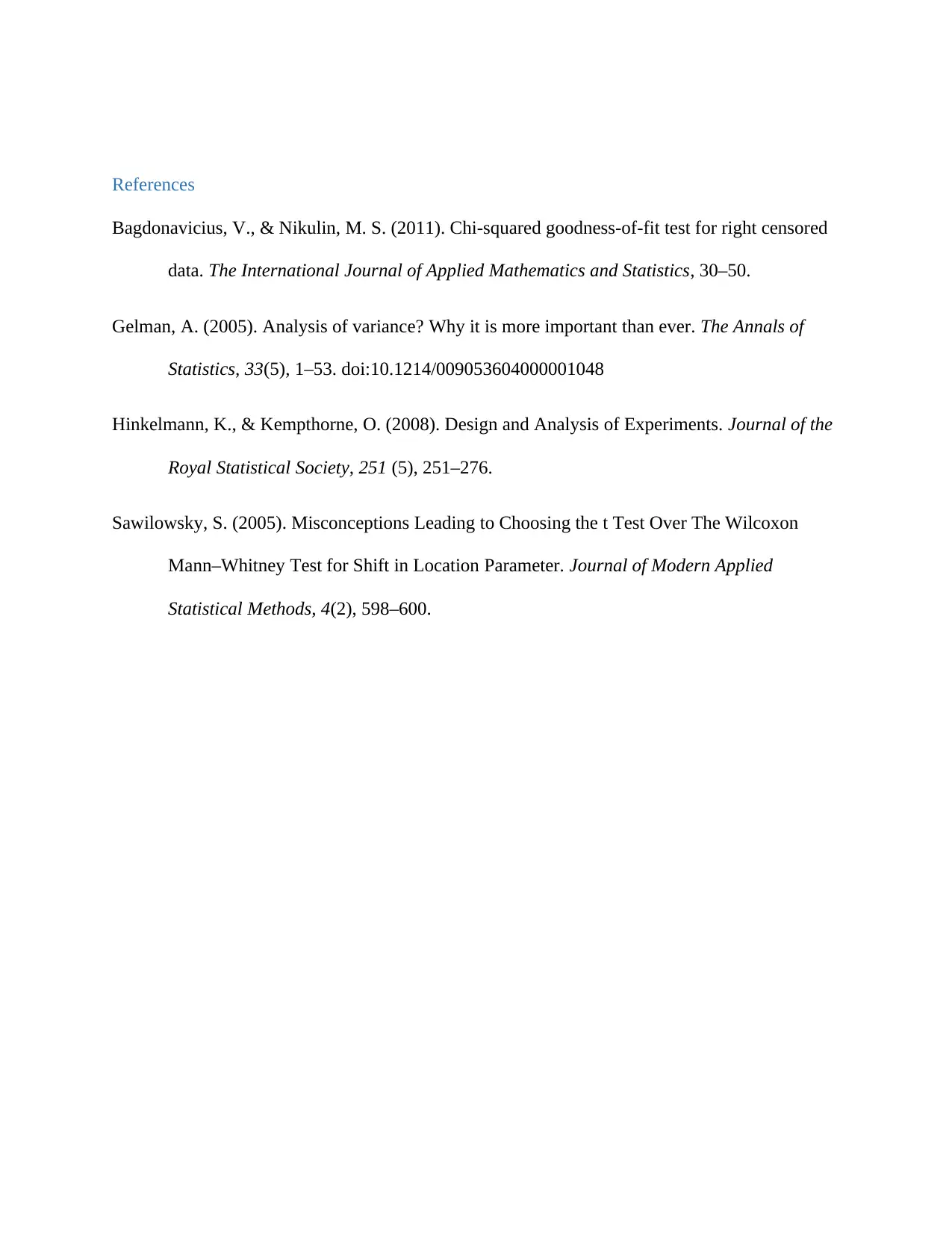
References
Bagdonavicius, V., & Nikulin, M. S. (2011). Chi-squared goodness-of-fit test for right censored
data. The International Journal of Applied Mathematics and Statistics, 30–50.
Gelman, A. (2005). Analysis of variance? Why it is more important than ever. The Annals of
Statistics, 33(5), 1–53. doi:10.1214/009053604000001048
Hinkelmann, K., & Kempthorne, O. (2008). Design and Analysis of Experiments. Journal of the
Royal Statistical Society, 251 (5), 251–276.
Sawilowsky, S. (2005). Misconceptions Leading to Choosing the t Test Over The Wilcoxon
Mann–Whitney Test for Shift in Location Parameter. Journal of Modern Applied
Statistical Methods, 4(2), 598–600.
Bagdonavicius, V., & Nikulin, M. S. (2011). Chi-squared goodness-of-fit test for right censored
data. The International Journal of Applied Mathematics and Statistics, 30–50.
Gelman, A. (2005). Analysis of variance? Why it is more important than ever. The Annals of
Statistics, 33(5), 1–53. doi:10.1214/009053604000001048
Hinkelmann, K., & Kempthorne, O. (2008). Design and Analysis of Experiments. Journal of the
Royal Statistical Society, 251 (5), 251–276.
Sawilowsky, S. (2005). Misconceptions Leading to Choosing the t Test Over The Wilcoxon
Mann–Whitney Test for Shift in Location Parameter. Journal of Modern Applied
Statistical Methods, 4(2), 598–600.
⊘ This is a preview!⊘
Do you want full access?
Subscribe today to unlock all pages.

Trusted by 1+ million students worldwide
1 out of 26
Related Documents
Your All-in-One AI-Powered Toolkit for Academic Success.
+13062052269
info@desklib.com
Available 24*7 on WhatsApp / Email
![[object Object]](/_next/static/media/star-bottom.7253800d.svg)
Unlock your academic potential
Copyright © 2020–2025 A2Z Services. All Rights Reserved. Developed and managed by ZUCOL.





